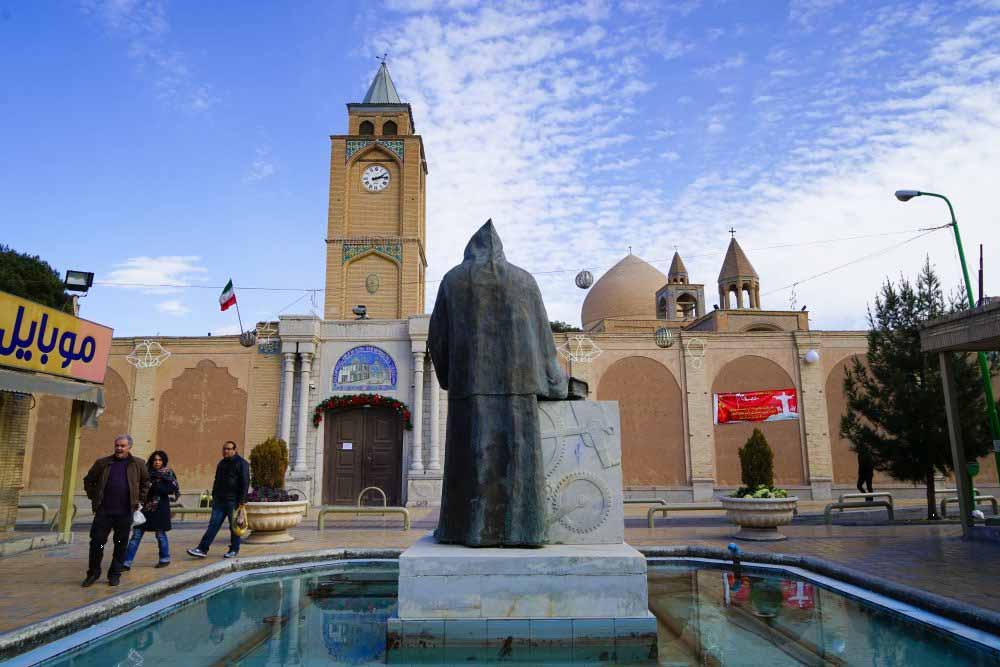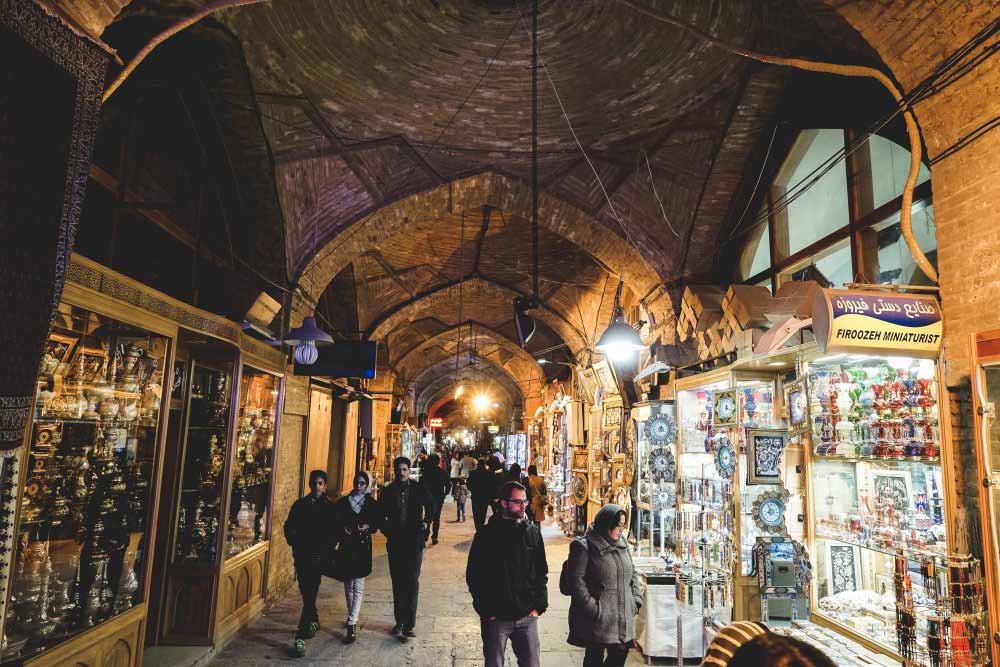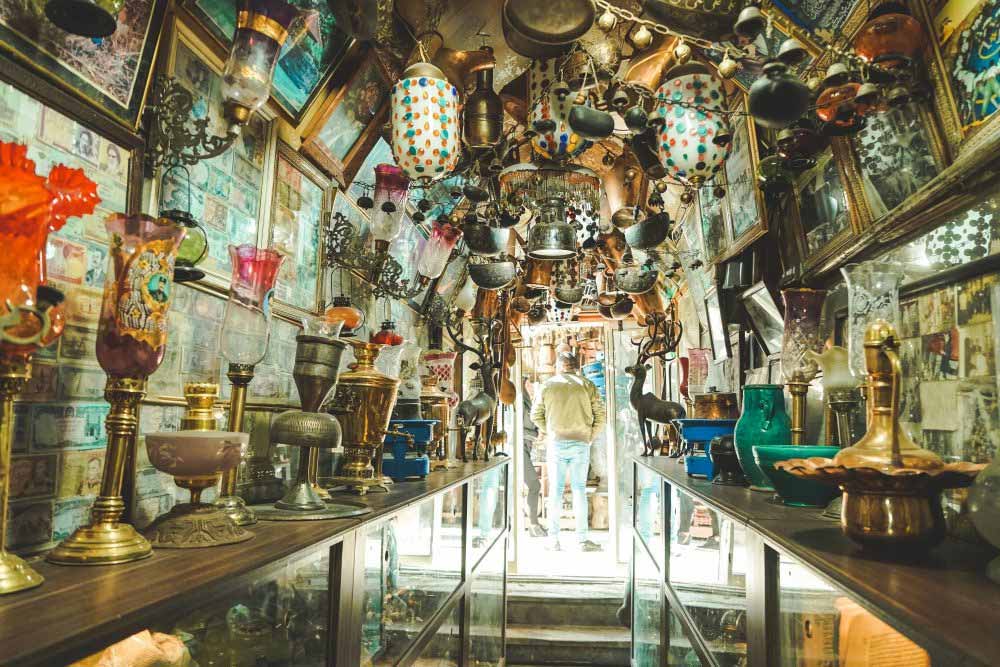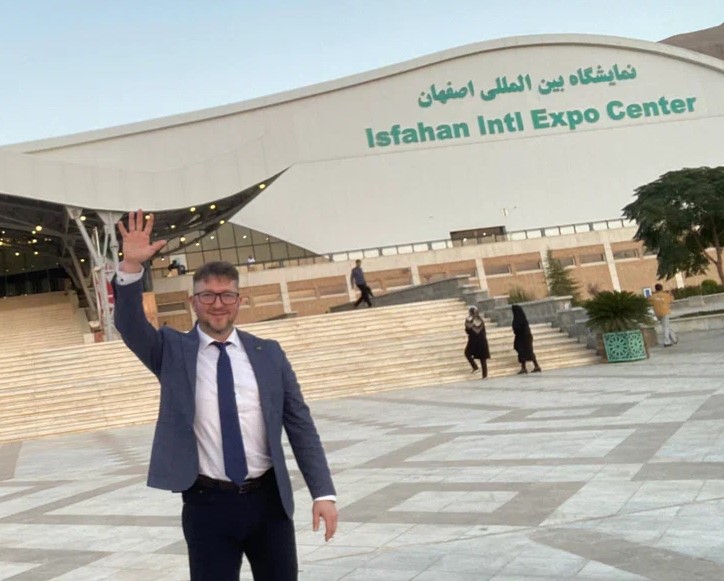Esfahan (or Isfahan) is the third biggest city in Iran – and one of its most cultural important and one of the largest cities in the world in its heyday during the 16th century. This led to the Persian proverb “Esfahān nesf-e- jahān ast” (Esfahan is half of the world). At one stage Isfahan was the biggest city on Earth but now it is a relevantly quiet town known around the world for its beautiful architecture and breathtaking public spaces.
With three UNESCO World Heritage sites, a myriad of food options to explore, some of the biggest and most beautiful mosques in the world and relatively little tourism – Isfahan should be top of every traveler’s list in Iran.

Naqsh-e-Jahan-Square-Esfahan-At-Night
Isfahan: The City of Four Seasons
Isfahan is located in the central Iran inside the plains stretching along Zayandeh Rood River. The city is located in a relatively mountainous area in the center of the Iranian Plateau and stretches from the snowy Zagros Mountains in the West to the East and North-central deserts of Iran. There exists a variety of climatic conditions in the city thanks to regions with different altitudes.
Generally, as the altitude falls from Western city to the Eastern, the area temperature increases together with the decrease in the amount of rainfall. There is a breeze drifting in the city throughout the four seasons. The Western and Southwestern winds which blow along Zayandeh Rood River in the spring and fall endow the city with a glorious weather. Isfahan is a city with regular seasonal changes. Spring begins in late March with the trees in full bloom, summer in late June. The city greets fall color in late September with the leaves falling off the trees and winter starts in late December. Among all the seasons and months, Isfahan is in its perfect splendor in May. It’s the month when a breeze from the sky drifts through the colorful city in possession of a pleasant weather and luring lights. Isfahan is dowered with a full sunlight and is sunny three fourth of a year.

Chehel-Sotoun-Esfahan-Persian-Garden
Isfahan: A Museum Where People Live
With its old history and numerous monuments, Isfahan is an exemplary city in the world. According to the French author, Andre Malraux, only Florence and Peking are comparable to Isfahan. The historical monuments of Isfahan comprise a collection of the finest examples of the various styles of Persian architecture developed throughout a period of thousand years and more. The quality and quantity of these works of art are great and they are masterpieces of the post-Islamic Iranian architecture .Among the historical attractions of Isfahan various types of domes, tile works, plaster works, fresco wall paintings and calligraphies can be named. These works reveal the religious beliefs of their creators and fascinate the visitors so greatly that they feel as though they have been taken back to the ages of the artists and find themselves in a world replete with light and elegance.
Isfahan: A World of Art
Isfahan is called the city of Iranian handicraft and traditional arts. These works of art comprise a major portion of Iran’s exports, particularly to Europe. The contemporary traditional arts and handicrafts of Isfahan are in fact a continuance of the Safavid Art pursued by the modern Iran craftsmen. Their artistic works are appreciated by Iranians and non-Iranians alike, and play a pivotal role in exports from Isfahan. Carpet weaving, engraving, miniature painting, Moarragh, tile art, brocade, calico work and enamelwork are among the most prominent works of art in Isfahan. The contemporary artists of Isfahan have made new innovations in recent years in the areas of miniature painting, tile making and engraving. Isfahan also has an age-old musical tradition. Today, most Iranian musicians speak Persian with an Isfahan accent.


Isfahan Handicrafts
Weather
Isfahan has a dry continental climate with four distinct seasons. Summer months extending from June to August are hot and dry and winter months beginning from December and lasting to February are cold with sporadic snowfalls. Therefore, the best seasons to visit Isfahan are spring and fall when the weather is sunny, warm and pleasant for sightseeing and outdoor activities. Although there is extreme heat and cold in the city, the cold days do not last longer than three months. In Isfahan, it hardly ever snows in winter. There is usually rainfall in March and April, probably because of the clouds made from the evaporation of the thawing snow. A wind coming from the west keeps blowing throughout the summer. When the sun sets, the wind picks up and it gets so cold at night that one might want to wear a woolen coat. Spring starts in February when the weather becomes balmy and the city gets back its charm.

Naqsh-e-Jahan-Square-Esfahan
The Present Day of Isfahan
Isfahan has achieved a significant growth and development in the past decades. It has turned into a modern city following an increase in its population, development of its urban area and formation of new streets as well as the rise in the number of buildings and plants. Isfahan has witnessed a dramatic growth after the Islamic Revolution.

ESFAHAN AT A GLANCE
Isfahan Province is the 1st industrial province in Iran
Isfahan is the 3rd largest metropolis in Iran
Middle East’s largest steel company & the World’s Largest Sponge Iron Producer is located in Isfahan.
Isfahan major exports: Petrochemicals, Ceramics, Steel, Carpet, Handicrafts, Dairy products.
Isfahan major export destinations: Iraq, Afghanistan, Pakistan, Turkmenistan and UAE.
Number of Industrial Town in Isfahan: 80
Isfahan accommodates 40% of the country’s textile industry
Isfahan is located at the center of a crossroad connecting Iran’s North to South and East to West.
Isfahan is Iran’s stone and textile hub
Isfahan hosts over 2000 textile units
Isfahan is known as the industrial hub of Iran
Isfahan accommodates 600 decorative stone quarries
50% of Iran’s stone produced in Isfahan (4.5 million tons of decorative stones per year)
World oldest hotel, the 5-star Abbasi hotel, is located in Iran
Number of handicrafts in Isfahan: 250
Fun Things to Do In Isfahan Iran: Persian Architecture Extravaganza
(Source: inspiredbymaps.com)
- Wander the Great Expanse of the UNESCO World Heritage Naqsh-e Jahan Square
While itself home too many of the marvelous attractions of Isfahan, the Naqsh-e Jahan Square deserves a mention in its own right – if not because it is one of the biggest public plazas in the world.
Built to symbolize the importance of Isfahan in the Safavid Empire – not much has changed except the addition of horse-drawn carriages, a beautiful fountain, and hordes of tourist shops. You can’t avoid this square even if you wanted to – but is best visited in the late afternoon or evening when Iranian families and couples come out to enjoy its splendor and the light is more mallow.

- Potter over the Historic Zayandeh River Bridges
Isfahan is endowed with no less than 11 bridges .These bridges are popular places for locals to gather at any time of day, but especially in the evening as the bridges are perfectly lit up. The Si-o-Seh Pol Bridge is a perennial favorite – and the longest, though Pol-e Khaju may well be the finest bridge in Iran. Don’t miss Pol-e Shahrestan which is the oldest dating back to the 12th century or Pol-e Chubi with its interior parlors used by the shah and his concubines.

- Climb up The Isfahan Fire Temple for Incredible Views
Dating back to Sassanian times there is not much left of the crumbling bricks at Ateshkadeh-ye (the Isfahan Fire Temple) but the panoramic view from the top over Zayandeh River and the edge of Isfahan make it all worthwhile.
A slippery and treacherous path requires a 20-minute scramble uphill, but as long as the weather is good it’s worth it to wander amongst the ancient (or often rebuilt) ruins and gaze out to the horizon.
Not the best example of a Zoroastrian Fire Temple in Iran, but there is still a certain otherworldly charm up here ave it all.

- Sample the Traditional Food of Isfahan
One of the highlights of Iran is the food and Isfahan is no exception.
You absolutely must try Biriyani when here, minced lamb served with bread and Faloodeh which is a cold dessert of corn vermicelli noodles in rosewater syrup.

- Marvel at the Exterior Of The Grand Masjed-e Shah ( Masjede-e Imam) Mosque
The center point of the city, Masjed-e Shah Mosque otherwise known as the Abbasi Great Mosque is elegant and iconic – and by far the biggest building on the square.

- Learn the Intriguing History of Jolfa: The Armenian Quarter in Isfahan
Jolfa is the Armenian quarter in the south of Isfahan.
Dating back to the 16th century when Shah Abbas the First ordered the transportation of the entire population of Jolfa ad hoc, a town boarding Armenia, to Isfahan to help complete his historic architectural works here in record time. These new populations’ talents as merchants, entrepreneurs and artists were needed, and it was ensured their religious freedoms were respected…though at quite a distance from the Islamic monuments he was creating.
Today Jolfa is a very fashionable and liberal enclave serving the needs of the remaining 6,000 Armenian Christians here – with many beautiful restaurants, cafes, hidden churches and a vibrant feel around the central Jolfa Square. A curiosity deep in the heart of Iran that no travelers who visiting Isfahan should skip!

- Decide If the Shaking Minarets of Monar Jonban Really Defy Physics.
A 14th century architecturally undistinguished shrine which covers the grave of Amu Abdollah Soqla, Monar Jonban has become famous for its shaking minarets.
Every 1.5 hours one of the minarets is shaken and the other minaret should be observed to shake in unison swell. Locals will tell you that science cannot explain the miracle of the shaking minarets of Monar Jonban, but in actuality, it is simply an example of couple’s oscillation given the height of the minarets and width of the roof. Then, perhaps you will get lucky and see the laws of physics defied. Best combined with a trip to the Isfahan Fire Temple.

- Enter the Hidden & Secretive Vank Cathedral in Isfahan
The beautiful Vank Cathedral, formally known as the Holy Savior Cathedral, stands at the heart of the Armenian Quarter, whose entrance is hidden behind a discreet wooden door.
Hidden away behind high walls to avoid offending the Islamic rulers over the centuries – all can be seen is a small cross on a done similar to a mosque but once inside you there is plenty of glorious wall paintings and an interesting collection of bibles.
If you have never been inside an Armenian Church the Vank Cathedral is the perfect place, if you can catch it when it’s open between baptisms and weddings.

- Get Lost On the Depths of the Isfahan Grand Bazaar
Locally known as Bazar-e Bozorg, the historic and seemingly endless Isfahan Grand Bazaar spreads all the way from Naqsh-e Jahan Square through to Masjed-e Jameh…Quite the distance.
Open from 8 am till 9 pm – the best time to visit the Isfahan Bazaar is mid-morning if you want to experience hustle and bustle, or the evenings for a more subdued experience. Make sure to admire the gorgeous brick-arches, stop by a carpet shop to admire to learn about the ancient history of Persian carpets and pick up some saffron from the spice markets to take home.
You can easily lose half a day here, and the best way to see it is to simply wander – though if you are actually looking for something specific, it is best to ask directions!

- Get Snap Happy At the Photogenic Azadegan Teahouse
Possibly one of the best teahouses in Iran, a trip to Isfahan would not be complete without seeking out the Azadegan Teahouse.
Located in a hidden alley off the Naqsh-e Jahan Sqaure, this place is insanely popular with locals on the weekend who come for the delicious tea and traditional food. However, most tourists go for the ridiculous collection of oddities and curiosities covering almost every single surface and flowing outside into a courtyard as well.
In this cave of wonders service is rushed off their feet, but really you won’t be in a hurry to leave this interesting and utterly unique space…

- Admire the Stunning Inner Sanctuary of Masjed-e Sheikh Lotfollah
A harmonious, almost discrete, compliment to the Grand Masjed-e Shah Mosque – the Masjed-e Sheikh Lotfollah is small but packs a big punch.
With a twisting hallway leading to an unforgettable inner sanctum, covered in complex mosaics and a ceiling like no other it is surely worth the hefty entrance fee. Be sure to take you time and enjoy this masterpiece of design in Isfahan famed for the shafts of sunlight with peak through the windows in its dome – creating a short of light and shadow any photographer will love.
Try to visit in the mid-morning for a quiet, almost sacred experience, and stay as long as possible to admire the way changing light changes the space.

- Find Magic on Friday Nights under the Khaju Bridge
Constructed to highlight the natural beauty of a river, the Khakju Bridge, Khaju Bridge is “the culminating monument of Persian bridge architecture and one of the most interesting bridges extant…where the whole has rhythm and dignity and combines in the happiest consistency, utility, beauty, and recreation.”
While you should visit during the day as well, on Friday nights young lovers and friends gather under its base for picnics and what I can only describe as Iranian glee – a sort of sing-off where operatic songs in Persian echo under the arches and everyone competes to out-do each other.

- Get the Best View of Isfahan at Kakh-e Ali Qapu
While this six-story palace has a long history dating back to its use as residence for Shah Abbas I in the 16h century, today it is perhaps best known for its view of the Isfahan Square and out to the mountains.
Slowly being restored after being largely destroyed during Qajar rule – don’t expect to see it completed anytime soon but the wooden ceiling, display of arts and craftsmanship do add a nice bonus to the view.

- See One of the Best Remaining Examples of A Persian Garden At Chehel Sotun Palace
Overlooked by many travelers, the Chehel Sotun Palace is actually a UNESCO World Heritage site as it exemplifies Persian garden design and evolution since the 6th century BC.
Always divided into four sections – following the Zoroastrian principles of earth, sky, water, and planet coming together to produce Eden. The Chehel Sotun Palace is a perfect representation of this with its beautifully preserved palace, long reflection pool, and quiet side gardens. Feel at peace amongst the tranquil – and perfectly symmetrical – gardens and elegant palace terrace.

- Learn the Intricate History of Isfahan carpet
Isfahan is famed for its achievement in arts and crafts and today it’s most famous export – the Isfahan carpet – is still world renown in quality and style.
You can see artisans at work on these carpets all over the city, and while the price of a Persian Rug is mind-boggling – it’s not hard to see why when it can take up to four months just to produce one square meter. Pop your head into any shop and the sales person will happily show you all the different styles and construction techniques just like a free museum tour.
You are by no means obligated to buy anything, but just be upfront if this is the case and he will still proudly show you these beautiful works of art.


More about Isfahan:















